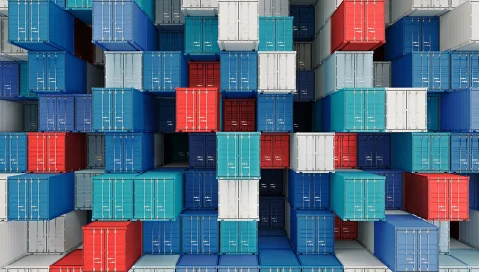Container Visibility: Know Where Your Consumer Goods Are Every Step of the Way
Container Visibility: Know Where Your Consumer Goods Are Every Step of the Way
Container Visibility: Know Where Your Consumer Goods Are Every Step of the Way
7 Sep 2021
Ken Weygand
For importers and distributors of consumer goods, supply networks used to be fairly reliable. Most companies had a dependable product source and a manageable (and relatively stable) cost for each container.
Then the pandemic happened, and it plunged international shipping into crisis.
Supplier delays, production problems and pressured port infrastructures have made the process of getting goods from A to B longer, less predictable and more expensive than ever before. And for import and distribution businesses, this is creating major logistical headaches that can only be solved with greater visibility over the end-to-end journey.
What Shipping Challenges Do Importers and Distributors Face Right Now?
One of the biggest issues for distribution companies today is physically getting inventory into North America. According to the Financial Times, there were around 22 ships waiting for a berth in the ports of Long Beach and Los Angeles at any time in August 2021, and those ships were waiting up to two weeks to drop anchor.
This backlog of vessels is significantly impacting imported goods—as container arrivals have slipped out of sync with inland freight pickups, putting customer delivery deadlines under pressure.
It’s not just timing affecting performance, either. International imports currently come at a significant price. The average cost to ship a 40-foot container has more than quadrupled in the past 12 months, reaching $8,399 in July 2021, according to data published in The Wall Street Journal. Some of the most popular routes have become even more expensive; list prices for shipping from China to the U.S. West Coast are now reaching $12,000 to $20,000 per container.
Given the cost and complexity of moving consumer goods, importers and distributors understandably want to keep tight control over inbound shipments. And knowing where your products are every step of the way enables you to manage both your business logistics and customer expectations.
Visibility Part 1: Managing Container Space
Increasing visibility over international shipments starts with knowing exactly what volume of container space you’ve got to work with and what products you’ve got ready. All too often, customer orders are compromised because suppliers quite literally miss the boat.
Shipping delays are particularly costly for distributors importing seasonal products. For example, ahead of this year’s Fourth of July celebrations, the American Pyrotechnics Association issued a statement, warning U.S. consumers to expect fireworks shortages as a result of supply chain and shipping problems in China.
Managing the point of export has become a major challenge because of the way in which companies coordinate logistics. Many distributors are still tracking orders via spreadsheets, which need to be completed manually. These spreadsheets are rarely up-to-date and it’s easy for multiple versions to be used within the business.
Even importers with enterprise resource planning (ERP) software in place may still be finding container management difficult because they’re using generic systems to create virtual warehouses. The problem with a generalist solution is that it can’t provide the level of detail needed to track inventory from end to end.
Ideally, distribution companies need specialist industry software that will enable your business to understand exactly what products are being shipped, how many units there are, their container number and expected arrival date. This way, you know exactly what’s coming, in what quantities, to promise to customers—and you set realistic delivery deadlines for those orders.
Visibility Part 2: Tracking Inventory In Transit
Understanding inventory at the point containers are loaded is critical to demand planning and order management. However, it’s not always plain sailing once products leave the dock. Importers and distributors also need to contend with the impact of travel disruption.
Unlike air and road freight, where time can be recovered relatively easily, bad weather or busy routes can put container shipments significantly behind schedule—and we’ve already mentioned the major docking backlog this can cause.
Currently, many consumer goods importers can’t see the scale of these delays until the moment containers don’t dock on schedule, because of the technology they’re using (or lack thereof). They’re reliant on team members checking with freight companies or brokers for updates, and without an up-to-date picture of where each container is, it’s hard to align arrival schedules with customer delivery deadlines.
With a specialist distribution ERP system in place, this process can be automated, so you can check the progress of every SKU in real time without having to phone someone or type in a tracking code. More importantly, your ERP software will alert you to any orders that are compromised by shipping delays—so you can start to understand (and mitigate) the impact on customer deliveries.
Visibility Part 3: Creating Open Customer Dialogue
Unfortunately, there’s not a lot you can do about delays in transit. However, if you keep your sales team informed, they can manage customer expectations; letting them know as early as possible if inbound shipping issues are affecting the progress of their order.
You can also use this insight to find satisfactory workarounds. For example, checking wider inventory availability to offer customers a similar substitute that’s currently in stock. Or if that’s not possible, giving them the opportunity to change or cancel their order, as writing it off in the short-term can build better relations in the long-term.
Equally, if you’re faced with limited stock of certain products and there’s no clear alternative, you may wish to prioritize larger orders or high-value customers, so you’re not jeopardizing your most profitable relationships.
Distribution ERP software can provide you with these insights, allowing you to feed data through to sales teams so they’re able to make effective decisions during customer meetings, based on real-time data.
And you can analyze the full revenue and sales impact of canceled or missed orders , to revise strategies and targets. Plus make plans for the inventory due to arrive that is no longer needed—such as selling it through to discount chains.
Longer-term, you can use distribution ERP technology to support logistics decisions. For example, it might be quicker, cheaper and/or more reliable for you to ship containers to a different port and transport inventory to your distribution centers via land freight.
Improving Inventory Management With Distribution ERP Software
It’s frustrating when circumstances beyond your control affect your trading abilities, and current market conditions are testing many importers and distributors to the limit. But although you can’t change external factors, your organization still has the power to limit the potential damage that delayed inbound shipments can cause.
Using distribution ERP software to track container movements in real time throughout their journey gives you a reliable, accurate data set to make smart decisions.
These decisions may disappoint customers in the short-term, but the further ahead of time you can let them know that their order is behind schedule, the greater opportunity you have to work together and find a suitable solution—and avoid a missed deadline counting against your supplier rating.
Moving away from manual spreadsheets and generic technology to import and distribution ERP software gives you the specialist tools to track in-bound shipments in real time, using that data to underpin demand planning, forecasting, inventory and order management.
Most importantly, it enables you to build honest, transparent relationships with your customer base, to grow their value and encourage long-term loyalty.
Aptean Distribution ERP is purpose-built for importers and distributors of consumer goods, to electronically capture information for integrated, informed decision-making.
Our ERP technology includes an Import Management feature, which tracks shipments, vessels and containers to provide visibility of inbound inventory and order fulfillment.
Book your free Aptean Distribution ERP demo to find out more.
Ready to start transforming your business?
We’ve got the specialised ERP solutions you need to conquer your industry challenges.



